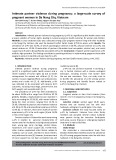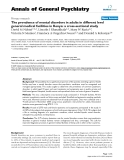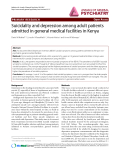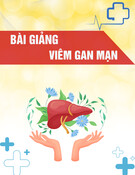
HUE JOURNAL OF MEDICINE AND PHARMACY ISSN 3030-4318; eISSN: 3030-4326 91
Hue Journal of Medicine and Pharmacy, Volume 14, No.6/2024
Intimate partner violence during pregnancy: a large-scale survey of
pregnant women in Da Nang City, Vietnam
Tran Dinh Trung1,3*, Vo Van Thang1, Nguyen Vu Quoc Huy2
(1) Faculty of Public Health, Hue University of Medicine and Pharmacy, Hue University
(2) Department of Obstetrics and Gynecology, Hue University of Medicine and Pharmacy, Hue University
(3) Faculty of Public Health, Da Nang University of Medical Technology and Pharmacy
Abstract
Introduction: Intimate partner violence during pregnancy (p-IPV) is a significant public health concern and
a severe violation of human rights, leading to numerous adverse health outcomes for women and children.
Methods: A cross-sectional study was conducted among 1235 pregnant women living with their husbands
in Da Nang City, Vietnam. We used the Revised Conflict Tactics Scales (CTS2) to assess p-IPV. Results: The
prevalence of p-IPV was 32.9%, of which psychological violence at 26.9%, physical violence at 14.7%, and
sexual violence at 12.5%. Chracteristics of partners (Education level occupation, alcohol use), and social
support were found to be significantly associated with p-IPV. Conclusions: Pregnant women experience p-IPV
exhibit a high prevalent. Our findings contribute to providing evidence in implementing programs that enable
pregnant women to identify and seek help for p-IPV.
Keywords: Intimate partner violence during pregnancy, Revised Conflict Tactics Scales, p-IPV, CTS2.
Corresponding Author: Tran Dinh Trung. Email: tdtrung.21ncs007@huemed-univ.edu.vn
Received: 20/8/2024; Accepted: 10/10/2024; Published: 25/12/2024
DOI: 10.34071/jmp.2024.6.13
1. INTRODUCTION
Intimate partner violence during pregnancy
(p-IPV) is a significant public health concern and a
severe violation of human rights [1] due to health
consequences for women and children [2, 3]. For
women, it causes negative effects such as depression,
anxiety and suicide risk [2, 4]. Additionally, p-IPV
was indicated to be associated with adverse birth
outcomes, including miscarriage, preterm birth, low
birth weight, and neonatal death [2, 5].
The prevalence of p-IPV has been estimated to
be about 25.0% with a range from 20.4% to 30.7%
globally. Notably, a high prevalence was reported in
Asia, accounting for 32.1% [6], with mental violence
being the most common, ranging from 13.7% to
26.5%, followed by physical and emotional violence
at 6.5% to 12.3%, and educational violence at 4.1% to
10.7% [6]. In Vietnam, there were 35.4% of women
experienced p-IPV in the north region [5] and 15.0%
in the central region [7].
Previous studies in Vietnam focused on examining
p-IPV in relation to personal characteristics of
women and their husbands including low educational
level, young age, early marriage, alcohol abuse,
housework, and social support [8]. Furthermore,
other studies emphasized other factors related to
husband, such as youth, intention to have children,
and preference for sons [9]. However, the assessment
of social support has not been comprehensive and
multidimensional [8].
p-IPV has not yet been reported in Da Nang, a
city in Central Vietnam with a diverse ecological
landscape, including districts that border both
the sea and mountains. Thus, our study aims to
to identify the prevalence of p-IPV among women
during pregnancy and identify factors related to
p-IPV in Da Nang City, Vietnam.
2. MATERIALS AND METHODS
2.1. Subjectives
Pregnant women in their third trimester (from
months 7, 8, 9 of pregnancy) living in Da Nang City,
Vietnam.
Selection criteria: women aged 18-49 years;
Women who are married and live with their
husbands; willingness to participate in the study.
Exclusion criteria: the study focused solely on
p-IPV by husbands. Violence from other family
members was excluded. Women whose husbands
were present during the interview. Participants
with acute, severe illnesses or undergoing inpatient
treatment in medical facilities.
2.2. Methods
Study Design
We conducted a cross-sectional study from
October 2022 to March 2023 to assess the prevalence
of p-IPV among pregnant women who live with their
husbands in Da Nang City, Vietnam.
























